This post was inspired by a Facebook conversation started by my friend Jarell Lindsey talking about a mobility-based squatting motion with the feet parallel as opposed to splayed out (BTW, have you check out the Physical Culture Club page yet???)
There are many different ways to squat whether it is bodyweight only or with an implement such as a barbell, kettlebell, sandbag, or even another person.
The particular squat I am talking about here is what I refer to as an Internal Rotation Squat. The Internal Rotation Squat differs from the traditional bodyweight squat in that the feet are parallel, as opposed to opened outward, and the squatting motion is accomplished by internally rotating the femoral heads within the hip sockets rather than relying on quad muscle power alone.
The Internal Rotation Squat requires MUCH more mobility, control, and mind power to accomplish since you must actually teach your body how to rotate the bones of the femurs within the hip sockets. This will take some practice!
Why Do This?
In order to begin generating what known as Internal Power (IP), you must have mobility in the inguinal area that the Chinese Internal Martial Arts refer to as the kwa. There is much, much more to IP than this, but having mobility in the kwa is an essential requirement. Additionally, even if you have no interest in IP or Chinese Martial Arts, having this type of mobility and control is an asset in any athletic endeavor or martial art, regardless of style.
Internal Rotation Squat – Bodyweight Version
Begin with feet slightly more than shoulder-width apart. Keep the feet facing forwards, as if on railroad tracks.
This will be important later when working on winding the tissues, but for now, just do it. Place your fists on either side of the kwa (inguinal area) where the femur bones connect in to the hip sockets. Use the imagery of turning your fists to aid in turning the bones. Internally rotate the femoral heads and sit down into the kwa.
Squat as low as possible while keeping your back straight and the weight mid-foot balance. Pause at the bottom then externally rotate the femoral heads to stand back up.
Internal Rotation Squat – Goblet Squat Version
All requirements are the same as above with the addition of holding the kettlebell in front of your chest in the Goblet Squat position. Use the weight of the kettlebell to allow you to sink further into the kwa.
Thanks to Dan Harden for teaching me this exercise in the context of working on Aiki/IP. Any errors or omissions are my own and not the responsibility of my teachers. Also, thanks to Jaime for helping me to refine the squat and for taking the pictures!
Also, Dan Harden will be back in NJ in March 2014. Details on the seminar can be found HERE <<====
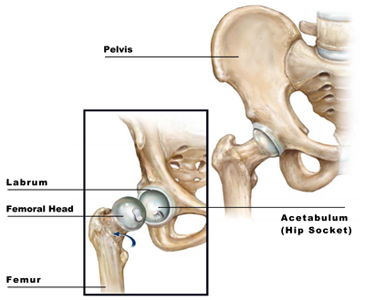
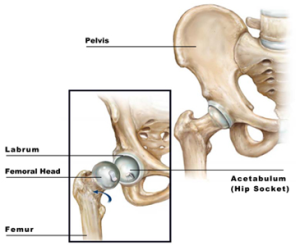
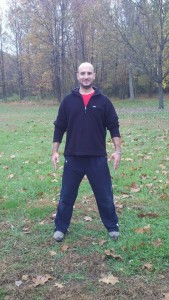
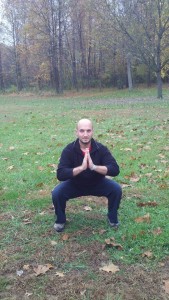
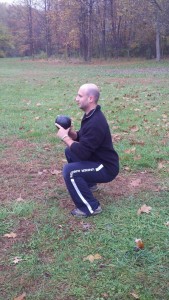




5 Comments
ccdev
February 14, 2015hello Jon,
thanks for sharing this (imho) vital info. i’m doing aikido, so i think this helps but i’m not sure if i’m doing it right and would appreciate some advice. when i do the squat, I feel a lot of weight on my knee, is that normal? and mid-foot is between the heel and ball of feet, right? any my last question if you could, when u lower yourself do you breathe in or breathe out, is that really important?
Jon
February 14, 2015You’re welcome! No, there should be no pressure or torque on the knees at all. If you feel any type of shearing in the knees, it is wrong. Yes, mid-foot balance is behind the ball of foot. It is easier to exhale when lowering and inhale coming up in this exercise.
Jon
ccdev
February 19, 2015Jon,
could you please help me understand – if the pressure is not on the knees, do i feel it on my quadriceps when i lower myself? Also in the pics your thigh seems to be horizontal with the ground, so when u say “squat as low as possible” that could mean that my butt could be touching/very close to my heel or the ground (like squatting beggar-style) but that doesn’t seem to be what you are doing, ???
Steve
May 3, 2015You mentioned imagining the hands sides of Kwa and rotating the Femoral heads. Is this rotating bottom to top? is this visualization or actually rotating with physical action.
Jon
May 7, 2015Actual physical rotation, aided and enhanced by visualization.
Leave A Response